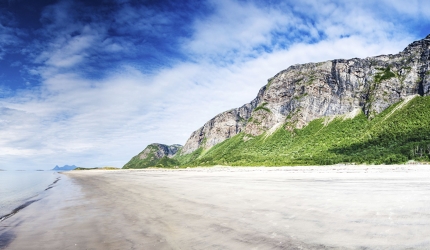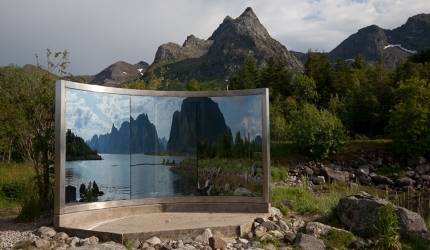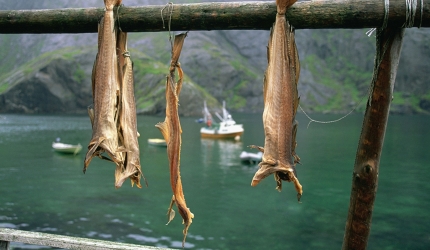Falling hook, line and sinker for Lofoten, Norway
The Lofoten Islands in Norway offer epic vistas, remote art installations and the best fish burgers Rudolf Abraham has tasted. But the archipelago faces an uncertain future.
The E10 highway winds sinuously along the Lofoten archipelago. Hopping between islands over a series of bridges, the road comes to an abrupt end at the village of Å (pronounced ‘o’ in English), which, fittingly enough, is the last letter of the Norwegian alphabet.
The landscapes in this corner of the world are breathtaking, particularly on the western coast of Lofoten, where, earlier, I had driven past shimmering fjords, soaring mountains and white sandy beaches, which wouldn’t have looked out of place in Hawaii.
I had also passed old, brightly-coloured fishermen’s cottages, clustered together in small coastal villages, and watched epic panoramas appear at every turn. I even spotted sea eagles, soaring through the skies above, scanning the ocean for prey.
Floating 200km (124 miles) north of the Arctic Circle, Lofoten juts out from Norway’s island-studded coastline and into the chilly Norwegian Sea, which has sustained the archipelago's fishermen for well over 1,000 years. Whalers have also plied these waters for generations, although their trade is tailing off.
 Lofoten's stilted fishermen's houses occupy stunning locations
Lofoten's stilted fishermen's houses occupy stunning locationsHarvepino / Thinkstock
This maritime theme runs through any visit to Lofoten. Fishermen’s cottages, known locally as rorbuer, are the quintessential form of accommodation on the islands. Simple but atmospheric, these stilted properties are usually perched above the shore and offer stunning vistas as standard.
The view from the balcony of my rorbu in Olenilsøy is certainly something to behold; across the fjord I see a cluster of yellow cottages, framed by fang-like mountains, all of which reflect in the limpid waters of the Reinefjord.
Lofoten’s wild side
I travelled to Lofoten via ferry from Bodø on the mainland, cruising over a sea as flat as glass, catching my first glimpses of the archipelago in the shimmering light of dawn.
Despite the calm of this journey – and the still, shimmering waters I have been marveling at since I arrived – Lofoten is renowned for its phenomenal tidal currents, which were the inspiration for Jules Verne’s 20,000 Leagues Under the Sea and Edgar Allan Poe’s dramatically titled A Descent into the Maelstrom.
The archipelago is certainly a land of contrasts. In the summer months the midnight sun never sets, instead rolling lazily along the horizon, with sandy beaches such as Utakleiv, Unstad and Eggum providing spectacular spots for midnight sunbathing.
 Lofoten's beaches look tropical, but feel Arctic
Lofoten's beaches look tropical, but feel ArcticLamarinx / Thinkstock
During the winter, however, the darkened islands provide one of the best locations in the world for viewing the northern lights – an unforgettable sight as they flush green across the sky, above glittering silhouettes of snow-streaked mountains and the red and yellow fisherman’s cottages.
As if the landscape weren’t enough, there are plenty of cultural attractions to be found on Lofoten. I leave the comfort of my rorbu and head for the island of Vestvågøy to admire a reconstruction of the largest Viking longhouse ever found. Historians believe it may have been the seat of one of the most powerful chieftains in northern Norway.
I stop too at the stone fort of Eggum – the site of a German radar station during WWII – where I follow the coast along a rough dirt track, admiring the mountains and watching sheep graze on lush, green grass.
A 20-minute walk from the fort, I find what I’m looking for; a sculpted bronze head on a column, which appears the right way up when viewed from one side, and upside-down when viewed from the other. The sculpture is called, simply, Head, and is the work of Swiss artist, Markus Raetz.
It forms part of the Artscape Nordland project, featuring 33 works by 33 international artists which are scattered across 33 municipalities in northern Norway. Several installations can be found on Lofoten; a large stone circle on Flakstadøya; an enormous glass mirror on Austvågøya; and a sculpture inspired by the island’s migratory birds on Røst. The journey to each one of them is as breathtaking as the art.
 One of a number of art installations to be found on Lofoten
One of a number of art installations to be found on LofotenCreative Commons / Jon Olav Eikenes
An uncertain future
On my last afternoon on the archipelago I walk from my humble abode to Sakrisøy, lured, not for the first time, by a delicatessen called Anita’s Sjømat, which, along with delicious cured cod, sells the best fish burgers I have ever tasted.
Air-dried cod (or stockfish) is one thing you are never far from on Lofoten. Fished in the winter months and hung up to dry outside on huge wooden racks, the cod are sorted into no fewer than 16 different categories depending on quality, and exported in vast quantities to Mediterranean Europe and West Africa.
The cod fishing industry has for centuries formed the mainstay of the Lofoten economy and permeates all aspects of life on the islands – the drying racks can be considered an integral part of the landscape, even in the summer when they’re empty. In the winter, when they are laden with fish and surrounded by snow, the racks are wonderfully photogenic, but step under them at your peril – the blood and oil dripping down is unlikely to wash out of your clothing in a hurry.
Despite the islands’ apparently unspoiled beauty, and their recent submission to be on UNESCO’s list of World Heritage Sites, there remains a note of uncertainty to their future. Plans for oil exploration and possible offshore drilling in the sea around Lofoten, though postponed, have not been shelved, and many believe the threat this poses – potentially catastrophic for the environment and fishing, not to mention tourism – may have been only temporarily averted.
 Cod fishing has formed the mainstay of the Lofoten economy
Cod fishing has formed the mainstay of the Lofoten economyMedioimages/Photodisc / Thinkstock
NEED TO KNOW
Getting there
Norwegian (www.norwegian.com) flies to Harstad/Narvik Airport from the UK (via Oslo), as well as to Bodø (also via Oslo) from where there are ferry connections (www.torghatten-nord.no) to Moskenes, Lofoten.
The Lofotenekspressen bus service runs between Harstad/Narvik Airport and Å, calling at Svolvær and Moskenes.
Where to stay
Rorbuer start from around £100 per night in summer, based on two people sharing. There’s a good list of rorbuer and other accommodation at www.lofoten-info.no.
Find out more
Visit Norway: www.visitnorway.com
Northern Norway www.nordnorge.com
Lofoten Islands www.lofoten-info.no
Related articles
The 20 islands you never knew existed
How Bermuda is reinventing itself
Do you have any Feedback about this page?
© 2025 Columbus Travel Media Ltd. All rights reserved. No part of this site may be reproduced without our written permission, click here for information on Columbus Content Solutions.









 You know where
You know where